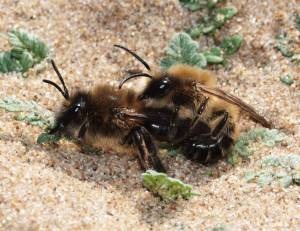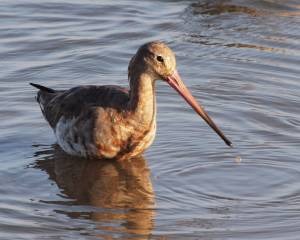Dr Phil Smith’s Wildlife Notes
March 2011
This is the month when nature really begins to respond to the call of spring. I saw my first Honey Bee as early as the 3rd, while Peacock and Small Tortoishell butterflies were out and about by mid-month. More unexpected was a large black-and-red sand-wasp (Ammophila sabulosa) at Cabin Hill on 27th. The following day, one of our national rarities, the Vernal Mining Bee, was active on the National Trust dunes and I was delighted to find and photograph a mating pair for the first time.

Bird-watchers always relish the arrival of spring migrants, Wheatears and Sand Martins being prime targets. The first Sand Martins I heard about appeared on 12th, when three were at Martin Mere and a single at Marshside. Wheatears started their passage a day later, with three at Seaforth and another at Martin Mere. However, I had to wait until 29th for my first sighting of six immaculate males and a female on the dunes at Southport Marine Lake. Swallows were relatively late this year, a possible first being at Martin Mere on 28th.
The now customary influx of Avocets continued during the month, with 30-40 at Marshside joining the usual Black-tailed Godwits, while Martin Mere had 74 Avocets by 27th. Much rarer were the Smew which lingered at the same site until mid-month, a Spotted Crake reported at Marshside on 18th and a Ring-necked Duck at Seaforth on 24-25th. The first Osprey of the spring flew north over Seaforth on 29th, while strong winds here on 31st blew in a party of eight Little Gulls. Being a North American rarity, the male Lesser Scaup at Marshside from 20th attracted lots of twitchers though, like most exotic ducks, an escape from a captive collection is always a possibility. Several reports of Green Woodpecker from different sand-dune locations during the month were encouraging as this bird is at best a scarce and irregular nester in our area.

I visited Birkdale Sandhills on 14th to see the excellent progress made by the council’s staff on clearing impenetrable stands of Sea Buckthorn and birch from the Local Nature Reserve. Sample counts of annual growth-rings on cut stumps showed that most bushes were about 15-20 years old, the largest dating back only 30 years at most, thereby confirming my recollection of a relatively open scrub-free landscape here when the reserve was declared in 1980. As well as extensive areas of scrub woodland at the rear of the dunes, Hawthorn, Holly, willows and other shrubs are being left. This will ensure a rich variety of wildlife habitats when the project is completed in another two years time.
The month concluded with a special study of the Early Sand-grass at Southport Marine Lake dunes. Said to be the world’s smallest grass, this tiny annual grows and flowers in February and March and then dies off completely leaving only its seeds to germinate in autumn. It was first discovered here in 1996 and, because of its national rarity, was the subject of detailed surveys in 1999 and 2004. Concerned that the plant may be declining, I mapped its distribution with the help of friends. Although some colonies have been lost due to overgrowth of tall vegetation, we were surprised and delighted to find that it has increased overall by about 40% since 2004. The grass is very dependent on open sandy conditions, these being maintained at Southport by Rabbit-grazing and human trampling.
